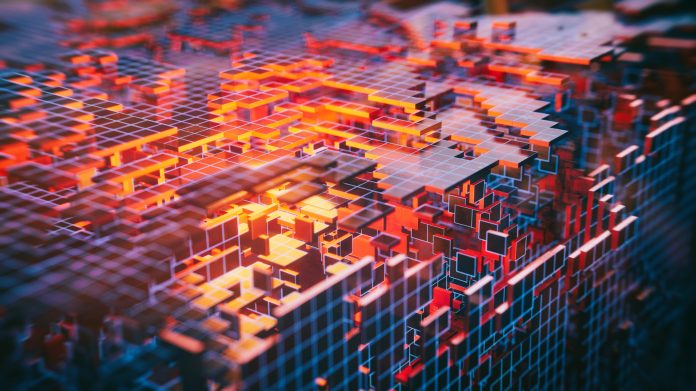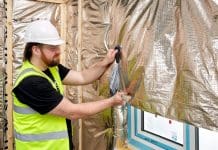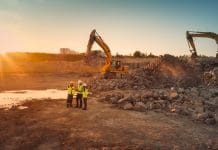AI has become a buzzword after some of the world’s most advanced AI technology has been made free for anyone to use. But we still don’t have a full picture of what AI in construction means or how we should leverage its potential
With game-changing AI-powered technologies like ChatGPT entering the mainstream, we’ve seen more interest than ever before in AI and what it could do for the construction industry.
Leveraging AI in construction can increase productivity, safety, sustainability and efficiency and, as a result, save time, reduce costs and improve the quality and environmental impact of buildings too.
AI in construction can also help us to make more informed decisions, faster – an advantage which might prove critical to addressing many of the sector’s key challenges at scale.
Using AI to overcome disruption is not new. When the Covid-19 pandemic hit in 2020 and the number of people on sites was restricted overnight, the industry was forced to find alternative ways of doing things. This ushered in an unprecedented and widespread adoption of technology, including AI, that would allow work to be done remotely.
Using AI-powered platforms for remote building inspections
One project led by the University of Strathclyde and Robert Gordon University (RGU) launched during the pandemic looked at the creation of an AI-powered online platform for remote building inspection and monitoring.
This technology introduces algorithms to detect defects in image data and creates an immersive 3D environment of a building. The project proposes a framework for the integration of methodologies and tools, including VR, to collect real-time data that will support automated decision-making.
Ultimately, this means that building control officers and safety inspectors can assess a building remotely and that checks could be carried out during (and after) the pandemic without increasing the number of people on site.
Finding scalable solutions to address the climate emergency
But the pandemic is not the only challenge facing the sector. When it comes to sector-wide challenges, nothing is more pressing than the climate emergency and finding scalable solutions to decarbonise and retrofit our built environment. As a sector we should be opening our minds and imagining the potential of AI to help us meet the retrofit challenge while ensuring the quality and speed of intervention.
Some businesses and researchers are already doing this. IRT, a thermal imaging and data capture and analysis company, has joined forces with academics at RGU and our sister innovation centre The Data Lab to develop a retrofit AI solution that reduces heat loss in homes.
Meanwhile, a project led by FES Group and supported by BE-ST is exploring technology that can take a 3D scan and apply AI technology to identify different objects within the image. In collaboration with the University of Aberdeen and Global Design Innovation, the team are looking at how this technology could be leveraged by the construction sector to capture data and process information, speeding up the data analysis process and ensuring safety and compliance.
This technology is already being used in existing retrofit situations and has the potential to be rolled out into further applications where it could support mass efforts to reduce carbon by retrofitting the current housing stock.
Where does BE-ST come in?
As the UK’s innovation centre for the built environment and construction, BE-ST is at the forefront of bringing emerging technologies to industry, increasing the awareness of the progress being made, supporting programmes that allow technology’s use to scale and, most importantly, asking what the potential of this technology is in accelerating the sector’s journey to net zero carbon.
And although interest in AI is there and is growing, we haven’t even begun to see how this technology could be applied to the built environment and construction. The entrance of players like ChatGPT into the mainstream begs the question of what a similar natural language processing tool, which is simple enough for a non-technical user, could do for the built environment sector, particularly in areas like building control, compliance and design?
It’s clear that the use cases are numerous and will be increasingly relevant across large parts of the industry. But developing a tool like this comes neither easily nor cheaply. Afterall, we are a traditional industry, facing the usual barriers of small margins and strict regulatory control.
And not forgetting the real ethical and legal ramifications of relying on AI tools to make decisions – particularly in a human-centric sector responsible for creating safe homes and major infrastructure.
Calls for the ethics of AI in construction need to be addressed
Concerns around the ethics of AI were echoed in the recent (and controversial) open letter published by the Future of Life Institute and signed by technology experts including co-founder of Apple, Steve Wozniak. The letter calls for a pause on the training of systems “more powerful than GPT-4” to make room for the regulatory, ethical and safety concerns of AI to be addressed.
Obviously, there’s a lot that still needs to be ironed out before we’re using off-the-shelf tools like ChatGPT to support the construction process. But there are a whole host of emerging AI and machine learning technologies trained on reliable datasets that offer huge potential to propel the sector into a safer, more efficient and productive era. This, coupled with the emergence of open-source AI and community-driven developments, is exciting and hints at a tangible path to wider adoption.
Implementing AI in construction and machine learning tools trained on reliable datasets would be a safe way to develop technologies that the sector can benefit from. If we are open to its applications, imagine how we can make it work for us and start to embrace this change, it will go a long way to helping us on our journey to solving some of the sector and society’s biggest challenges.

Matthew Paton
Associate impact manager – digital
Built Environment – Smarter Transformation
hello@be-st.build
www.be-st.build
Twitter
Linkedin
Facebook

















